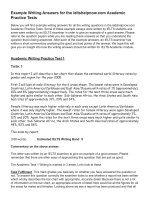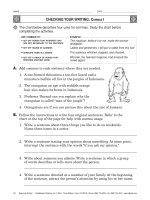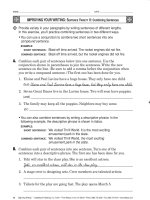Effective Academic Writing 1 potx
Bạn đang xem bản rút gọn của tài liệu. Xem và tải ngay bản đầy đủ của tài liệu tại đây (9.47 MB, 164 trang )
-i{-^
=
THE PARAGRAPH
ALICE
SAVAGE
North Harris
College
Houston, Texas
MASOUD
SHAFIEI
Kingwood College
Kingwood, Texas
OXFORD
LTNIVERSITY PRESS
OX_FORD
IJNIVERSITY
PRESS
198 Madison
Avenue
NewYork,
|{Y 10016
USA
Great Clarendon
Street,
Oxford
OX2
6DP
UK
Oxford
Universiry
Press
is a
department
of
the University
of
Oxford.
It furthers
the University's
objective
of
excellence
in research,
scholarship,
and
education
by
publishingworldwide
in
Oxford
NewYork
Auckland
Cape
Town
Dar
es Salaam
Hong Kong
IGrachi
Kuala
Lumpur
Madrid
Melbourne
Mexico
City
Nairobi
NewDelhi
Shanghai
Taipei
Toronto
With offices
in
Argentina
Austria
Brazil
Chile
Czech
Republic
France
Greece
Guatemala
Hungary
Italy
Japan
Poland
Portugal
Singapore
South
Korea
Switzerland
Thailand
Turkey
Ukraine
Vietnam
oxFoRD
and oxponn
ENGLISH
are registered
trademarks
of
Oxford
University
Press
@
Oxford
University
Press
2007
No unauthorized
photocoPYing
All rights
reserved.
No
part
of this
publication
may be
reproduced,
stored
in a retrieval
system,
or
transmitted,
in any
form
or by
any
means,
without
the
prior permission
in writing
of Oxford
University
Press,
or
as expressly
perrnitted
by law, or
under
terms agreed
with the
appropriate
copyright
clearance
organization.
Enquiries
concerning
reproduction
outside
the
scope
of the
above
should
be sent
to the
ELI
Rights
Depaltment,
oxford
University
Press,
at
the address
above.
You
must
not circulate
this
book
in any other
binding
or cover
and
you
must
impose
this
same
condition
on
any acquirer'
Any websites
referred
to
in this
publication
are in
the
public
domain
and
their
addresses
are
provided by Oxford
University
Press
for information
only.
Oxford
University
Press
disclaims
any
responsibilify
for the
content.
Executive
Publisher:
Janet
Aitchison
Senior
Acquisitions
Editor:
Pietro
Alongi
Editor:
Rob Freire
Art
Director:
Maj-Britt
Hagstead
Art Editor:
Robin
Fadool
Production
Manager:
Shanta
Persaud
Production
Controller:
Eve Wong
ISBN
: 978-0-
79430922-6
(STUDENT
BOOIQ
ISBN
: 978-0-19-430882-3
(ANSWER
KEY)
Printed
in
Hong Kong
709876
ACKNO\t'i-EDC\IE\TS
Cover
arl:
Richard
Diebenkorn
Ocean
Park
#122;
1980
oil
and
charcoal
on
canvas;
100 in. x 80
5/8 in.(254
cm
x204.79
cm)
San Francisco
Museum
of Modern
Art
Charles
H. t¡nd
Familiar
Foundation
Fund
purchase
@
Estate
ofRichard
Diebenkorn
SüIIs
photography
fo:
Clockwise
from
top
left: Purestock/Superstock:
2, Photo
Edit
Inc:
David
Young-Wolff,2;
Punch
Stock/Comstock:
2; Punch
Stock:
2;
Corbis:
David
Tirrnley,
30; Photo
Edit Inc.:
David Young-Wolff,52'
Punch
Stock/DGV:
Carl
Roessler,
76; Superstock:
Dwalme
L.
Harlan,
100;
Bruce Coleman
Inc':
G'
Krishnan,
122.
We
wouldlike
to
thank
the
followingfor
permission to
reproduce
these
extracts
and
ad ap
t ations of
c op
y
nght e
d mat en
al :
p.
31. G.S.
Sharat
Chandra,
excerpts
fronirsariof
the Gods.
Copyright
@ 1989
by
G.S. Sharat
Chandra.
Reprinted
with the
permission
of
Coffee
House
Press,
Minneapolis,
Minnesota;
p.
101. Adapted
ftomSeqttle
byJoel
Rogers,
@
2006,
with
permission of
Graphic
Arts
Books,
an
imprint
of Graphic
Arts
center
Publishing
company;
p.723.
Excerpts
from
"The
Green
Mamba"
from
GoingSolo
by
Roald
Dahl.
Copyright
@
1986 by
Roald
Dahl'
Reprinted
by
permission
of
Farrar,
Straus
and
Giroux,
LLC.
Acknowledgements
-We
would like to
thank David
Olsher, without
whom
we would never
have
started
this
project.
\(/e
want to
give
a special
thanks to the
editorial
team:
Rob
Freire, Kathleen
Smith, Kenna Bourke,
and
Scott Allan
Vallick for
their insight
and
expertise
,
and Pietro
Alongi
for his
endless
positivity
and
support.
\ü/e
would also
like to
gratefully
acknowledge
the work of
Susan Kesner
Bland.
Last but not least,
our
gratitude
to the following
reviewers
for their
contribution
to the project:
Sharon Allerson,
East LA
Community
College; Frank
Cronin,
Austin
Community
College;
Kieran
Hilu,
Virginia Tech;
Peter Hoffman,,
LaGuardia
Community
College;
Carla l\yssen,
California
State
lJniversity Long
Beach; Adrianne
Ochoa;
Mary O'Neill,
North
Virginia Community
College; Maria
Salinas,
Del Mar
College.
I
would
like
to thank
the administration,
faculty
,
and staff
of l\orth Harris
College
for making it
an inspiring place
to work. I
especially
want to
applaud the students
of the ESL
program.
Your
papers
are full
of delightful
surprises and interesting
insights. Thank you
for
allowing
your
work
to
be used to assist
others. Finally, I
wish to thank
my husband, Masoud,
and children
Cyrus
and Kaveh, for helping me
balance
work
and home. I always look
forward
to seeing
you
at the end of the day.
A.S.
I
would
like
to express my
appreciation to everyone
at Kingwood
College for
creating
a
great
environment for teaching
and learning. I
am especially
grateful
to the ESL faculty for
their
insightful
suggestions
and to the ESL
students
for
their
generosity
in
sharing their writing. Lastly,
and
most
importantly, I would like
to
thank my wife Alice for working
with me on this project
and our sons Cyrus and
Kaveh for adding so much color
to our
lives
each and
every day.
M.S.
Contents
lntroduction
Unit 1
:
The Sentence and the
Paragraph
PART 1:
Stimulating
ldeas .
The Paragraph
Formatting a
Paragraph
PART 2: Developing
a
Paragraph .
P aragraph Org anization
The Topic
Sentence
Supporting Sentences
The
Concluding
Sentence
PART
3: Unity and Coherence .
Unity within a Pangraph
Coherence within
a
Paragraph
PART
4: Editing Your
Writing
Simple
Sentence Strurcture
Punctuation
and Capitalization
Fragments
Run-on
Sentences
PART
5:
Putting
lt All Together
.
Unit
2: Descriptive
Paragraphs
PART 1:
Stimulating ldeas
.
Reading
Text:
"Sari
of the
Gods"
PART 2: Brainstorming
and Outlining
D
escriptive Org
anization
PART
3: Developing
Your ldeas
.
Using
Specific Language
PART 4: Editing
Your Writing
.
Using Adjectives in
Descriptive
\Triting
Using
Be
to Describe
and Define
PART
5:
Putting
It All Together
.
vl1
I2
T9
24
30
.) .'t
))
38
43
iv
Contents
+/
Unit
3:
Example
Paragraphs
PART
1:
Stimulating ldeas
.
j2
Reading
Text:
"Bumping
into Mr.
Ravioli"
PART 2: Brainstorming
and Outlining
ij
Example
Organization
PART
3:
Develop¡ng
Your ldeas
.
j9
Using Examples
as
Supporting
Details
PART 4:
Editing
Your Writing
.
65
Forming
and Using
the Simple
Present
Subject-Verb
Agreement
PART
5:
Putting
lt
All Together
.
69
Unit 4: Process
Paragraphs
PART 1:
Stimulating ldeas
.
76
Reading
Text:
"How
to Fight
Off
a Shark"
PART
2: Brainstorming
and Outlining
79
Process
Organization
PART
3:
Developing
Your ldeas.
84
Using Time
Order Words in Process
Paragraphs
PART
4: Editing Your
Writing .
90
Using Imperatives
Modals
of
Advice,
Necessify,
and Prohibition
PART
5:
Putting
It All Together
.
95
Unit 5: Opinion Paragraphs
PARTÍ:
Stimulatingldeas.
100
Reading
Text:
"City
with
a Gray-Green Heart"
PART 2: Brainstorming
and Outlining
. 103
Opinion
Organization
PART
3: Develop¡ng
Your ldeas.
. 108
Using Reasons
to Supp
ort an Opinion
PART
4: Editing
Your Writing
.
tL3
Using There
Is/Tltere
Are
to
Introduce
Facts
Using Because
of
and
Because
to Give Reasons
PART
5:
Putting
lt All
Together
.
tL7
Contents v
Narrative
PART
1: Stimulating
ldeas .
122
Reading
Text:
"The
Snake-Man"
Brainstorming
and
Outlining
.
125
Narrative
Organ
ization
Developing
Your
ldeas
.
. 130
lJsing Sensory
and
Emotional
Details
Showing
Order
of
Events
in Narrative
Patagraphs
Showing
Simultaneous
Events
Editing
Your
Writing
136
Forming
and
Using
the
Simple
Past
Forming
and
Using
the
Past Continuous
PART 2:
PART 3:
PART
5:
Putting
lt All
Together
.
r42
Appendices
PART 4:
Appendix
l:
The
Writing
Process
Appendix
ll:
Elements
of
Punctuation
Appendix
lll:
Glossary
Appendix
lV:
Correlation
t47
r48
149
to Grammar
Sense
I
L52
/
I
)
vi Contents
lntroduction
Effectiue
Acad,emic
Writing
is a three-book
series
intended to usher
students
into
the
world of
academic
writing.
The
goal
of the series
is to
provide
students
and
their
teachers
with a
practical and efficient
approach to
learning the skilis,
strategies,
and
knowledge
that are
necessary
for succeeding
in content coursework.
A
parallel
goal
is to
provide opportunities
for
students
to explore
their opinions,
discuss
their
ideas,
and
share their
experiences
through
written communication.
By
guiding
budding
writers
through
the experience
of composing
various types
of
paragraphs and
short
papers, we
hope to
provide students
with the tools and
the confidence
necessary
for
college
success.
The
Paragraph
Book
I
of
Effectiue
Academic
Writing,
Tbe Paragraph,
introduces
students
at the
high-beginning
to
low-intermediate
level to the academic
paragraph.
The
first unit
provides a
review of
sentence
structure and
an introduction
to developing
and
formattin
g
an academic
paragraph. Each of the
following
five units
then
addresses
a
particular
rhetorical
mode and
provides
user-friendly
guidance to
mastering
the
form.
The book
also
offers
numerous
opportunities
for
practicing
relevant
grammat
points.
All
grammar
presentations
and
practice
are
correlated
to Grammar
Sense
1.
Book
1 contains
several
features
designed
to support
students
in developing
the
skills
that they
need
for college
writing:
.
Each unit
contains
an authentic
text to
provide ideas
and context
for the
assignment.
o
At strategic
points in the
unit,
students
read and
analyze
authentic
student
paragraphs
to
see
how other
students
have written
on
the same
or similar
topics.
.
Each
unit contains
concise
and
effective
language
presentations
designed
to
develop
students'
understanding
of
rhetorical
modes
and
to improve
their
grammatical
accuracy.
.
Each
unit offers
useful
writing
outlines
so that
students
can
structure
their
writing
and
internalize
the
practice.
.
Each
unit
offers
collaborative
learning
activities
allowing
students
to
work
together
and
share
ideas.
.
At relevant
points
in
the
unit,
editing
exercises
and editing
checklists
are
provided
so
that students
can
refine their
writing.
.
Timed writing
activities
come
at the
close of each
unit
to
prepare students
for
in-
class
writing.
.
A series
of learner-friendly
appendices
are
provided
at the back
of the
book
to
encourage
student
independence.
A
glossary
of
common
grammffi terms
for
student reference
is included.
Introduction
vii
:\
I
Unit
Organization
Each unit
introduces
a theme
and
a
s-riting
task and then
guides
the
writer
through
a
five-part
process
of
gathering
ideas.
organrzing an
outline,
drafting,
revising,
and
editing.
As students
write,
they
practice specific skills
and
put
language
knowledge
to
work
to
produce a
patagraph
that
follon-s
academic
conventions.
The rhetorical
and
language-related
goals
of
the unit
are
identified on
the opener
page.
Part
1
Part
7 opens
with an
image
to spark
interest as students
begin
thinking
about
the
topic.
This is
followed by
u
short
authentic
text. Students
answer
questions about
the
text
that
will
help them
connect
the
writer's ideas
to their
own
knowledge
and
experience.
They
then
move
on to a
freewriting
activiLy,
an unstructured
writing
task
in
which
they can
explore
the
topic
without
worrying
about
organization
or
gÍammar.
Part
2
In Part
2 students
are
introduced
to a specific
rhetorical
mode.
They begin
by
brainstorming
ideas and
vocabulary
that
they
will
use to
write
their
paragraph.
They
then
learn about
rhetorical
organizational
features
and
read
and
analyze
a
student
parugraph.
Finally, students
produc e an outline
for the
paragraph
they
will
write
lafer in the
unit.
Part 3
In
Part
3
students
develop
the
ideas from
their outline
and
produce
a first
draft.
This
part opens
with a second
student
paragtaph
for students
to
analyze.
As
they
answer
questions about
the second
student
model,
students
review the
organizational
features
learned
in Part
2. They are
then
introduced
to specific,
level-appropriate
language
points that
will help
students shape
and
structure
their
writing.
Students
now
write
their
first draft and,
using a
peelreview checklist,
check
each other's
writing
for organízation
and clartty
of ideas.
Part
4
In
Part 4 students
edit their
writing
and
produce a
final draft.
This
part focuses
on
partictlar
grammar trouble
spots
relevant to the
theme
and the
rhetorical
style
presented
in the unit.
Following
the concise
language
presentation, students
complete
practice exercises
to help
them develop
their
grammar skills
and build
confidence.
Students
then
move on to
editing their
os/n writing,
and
produ ce a
final draft.
Part 5
The
final
part of the unit
is titled
"Putting
It All
Together."
This is the
summary
of
the other
parts
of
the unit.
Through a series
of skill exercises,
students
review
the
points covered
in Parts
7-4. They are
then
given the opportunity
to
write a
timed
paragraph
using a similar
rhetorical
focus, but
on a
different
topic. Guidelines
for
using their
time
efficiently
arc suggested.
This
part
also
provides
students
with
a
comprehensive
checklist to
review what
they
have written.
The unit closes
with
suggested
tasks
for
future writing
that can be
used
for
more
practice.
viii Introduction









